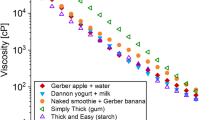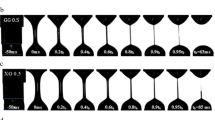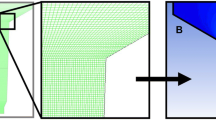Abstract
Recent studies show that understanding the rheological properties of thickened fluids, such as viscosity and yield stress, is advantageous in designing optimal thickened fluids for the treatment of dysphagia. To date, these studies have focused on the rheological behavior of thickened fluids in shear deformation, while limited information is available on the surface tension of thickened fluids or their rheological behavior in extensional deformation. Knowledge of the extensional properties of thickened fluids (extensional viscosity and cohesiveness) is important to fully understand the behavior of such fluids while swallowing. Our aim in this work, therefore, was to characterize water and skim milk thickened with a commercial thickener (xanthan gum based) to determine extensional deformation and surface tension properties. It was observed that the surface tension decreases as the thickener concentration increases due to the accumulation of the biopolymer at the surface of the fluid when it dissolves in water. In addition, the extensional viscosity of the fluid increased over time as the filament thinned (i.e., as the Hencky strain increased) until it reached a plateau. It was observed that the maximum extensional viscosity, which is related to the cohesiveness of the fluid, increases with the higher concentrations of thickener. However, the cohesiveness of thickened skim milk was lower than that of the thickened water at a given thickener concentration due to lower surface tension. This study confirms that by increasing the concentration of thickener, it will not only increase the shear viscosity (i.e., bolus thickness) of the fluid, but also the extensional viscosity (i.e., bolus cohesiveness).
Similar content being viewed by others
References
Logemann JA, editor. Evaluation and treatment of swallowing disorders. 2nd ed. PRO-ED Incorporated: Austin; 1998.
Nicholson TM, Torley PJ, Cichero JAY. The measurement of thickened liquids used for the management of dysphagia. In: Co A, et al., editors. XVth international congress on rheology—the society of rheology 80th annual meeting, Pts 1 and 2, Melville: Amer Inst Physics; 2008. p. 627–629.
Whelan K. Inadequate fluid intakes in dysphagic acute stroke. Clin Nutr. 2001;20(5):423–8.
Cichero JY, et al. The need for international terminology and definitions for texture-modified foods and thickened liquids used in dysphagia management: foundations of a global initiative. Curr Phys Med Rehabil Rep. 2013;1(4):280–91.
Althaus CB. Dealing with dysphagia. Food Food Ind. 2002;15(3):58.
Hanson B, O’Leary MT, Smith CH. The effect of saliva on the viscosity of thickened drinks. Dysphagia. 2012;27(1):10–9.
Leonard R, Kendall K, editors. Dysphagia assessment and treatment planning: a team approach. 3rd ed. San Diego: Plural Publishing; 2013.
Reimers-Neils L, Logemann J, Larson C. Viscosity effects on EMG activity in normal swallow. Dysphagia. 1994;9(2):101–6.
Cichero JAY, et al. How thick is thick? Multicenter study of the rheological and material property characteristics of mealtime fluids and videofluoroscopy fluids. Dysphagia. 2000;15(4):188–200.
Hadde EK, Nicholson TM, Cichero JAY. Rheological characterisation of thickened fluids under different temperature, pH and fat contents. Nutr Food Sci. 2015;45(2):270–85.
Hind J, et al. Comparison of standardized bariums with varying rheological parameters on swallowing kinematics in males. J Rehabil Res Dev. 2012;49(9):1399–404.
Atherton M, et al. Texture-modified foods and thickened fluids as used for individuals with dysphagia: australian standardised labels and definitions. Nutr Diet. 2007;64:S53–76.
Jukes S, et al. Evaluation of the uptake of the Australian standardized terminology and definitions for texture modified foods and fluids. Int J Speech Lang Pathol. 2012;14(3):214–25.
Garcia JM, et al. Serving temperature viscosity measurements of nectar- and honey-thick liquids. Dysphagia. 2008;23(1):65–75.
Sopade P, et al. Rheological characterisation of food thickeners marketed in Australia in various media for the management of dysphagia. I: water and cordial. J Food Eng. 2007;79(1):69–82.
Sopade P, et al. Rheological characterization of food thickeners marketed in Australia in various media for the management of dysphagia. III. Fruit juice as a dispersing medium. J Food Eng. 2008;86(4):604–15.
Garcia JM, et al. Viscosity measurements of nectar- and honey-thick liquids: product, liquid, and time comparisons. Dysphagia. 2005;20(2):325–35.
Hadde EK, et al. Rheological characterisation of thickened milk components (protein, lactose and minerals). J Food Eng. 2015;166:263–7.
Mackley MR, et al. The rheology and processing behaviour of starch and gum-based dysphagia thickeners. J Rheol. 2013;57(6):1533–53.
Salinas-Vázquez M, et al. Early Numerical Studies on the Peristaltic Flow through the Pharynx. Journal of Texture Studies. 2014;45(2):155–63.
GI Motility Online. Videofluoroscopic example of aspiration. Oral, pharyngeal and upper esophageal sphincter motility disorders 2016.
Nyström M, et al. Effects of rheological factors on perceived ease of swallowing. Appl Rheol. 2015;25:63876.
Lee B-B, et al. Surface tension of viscous biopolymer solutions measured using the du Nouy ring method and the drop weight methods. Polym Bull. 2012;69(4):471–89.
Lucas PW, et al. Food physics and oral physiology. Food Qual Prefer. 2002;13(4):203–13.
Fainerman VB, Miller R. Maximum bubble pressure tensiometry—an analysis of experimental constraints. Adv Colloid Interface Sci. 2004;108–109:287–301.
Tuladhar TR, Mackley MR. Filament stretching rheometry and break-up behaviour of low viscosity polymer solutions and inkjet fluids. J Nonnewton Fluid Mech. 2008;148(1–3):97–108.
Vadillo DC, et al. Evaluation of the inkjet fluid’s performance using the “Cambridge Trimaster” filament stretch and break-up device. J Rheol (1978-present). 2010;54(2):261–82.
Tembely M, et al. The matching of a “one-dimensional” numerical simulation and experiment results for low viscosity Newtonian and non-Newtonian fluids during fast filament stretching and subsequent break-up. J Rheol. 2012;56(1):159–83.
McKinley GH, Tripathi A. How to extract the Newtonian viscosity from capillary breakup measurements in a filament rheometer. J Rheol (1978-present). 2000;44(3):653–70.
Cichero J, Murdoch B, editors. Dysphagia foundation, theory and practice. West Sussex: Wiley; 2006.
Robbins J, et al. oropharyngeal swallowing in normal adults of different ages. Gastroenterology. 1992;103:823–9.
Docoslis A, Giese RF, van Oss CJ. Influence of the water–air interface on the apparent surface tension of aqueous solutions of hydrophilic solutes. Colloids Surf B. 2000;19(2):147–62.
Tomczynska-Mleko M, et al. Changes of secondary structure and surface tension of whey protein isolate dispersions upon pH and temperature. Czech J Food Sci. 2014;32(1):82–9.
Butler SG, Stuart A, Kemp S. Flexible endoscopic evaluation of swallowing in healthy young and older adults. Ann Otol Rhinol Laryngol. 2009;118(2):99–106.
Waqas MQ, et al. Shear and extensional rheology of commercial thickeners used for dysphagia management. J Texture Stud. 2017;48(6):507–17.
Molfenter SM, Steele CM. The relationship between residue and aspiration on the subsequent swallow: an application of the normalized residue ratio scale. Dysphagia. 2013;28(4):494–500.
Dantas R, et al. Effect of swallowed bolus variables on oral and pharyngeal phases of swallowing. Am J Physiol Gastrointest Liver Physiol. 1990;258:G675–81.
Newman R, et al. Effect of bolus viscosity on the safety and efficacy of swallowing and the kinematics of the swallow response in patients with oropharyngeal dysphagia: white paper by the european society for swallowing disorders (ESSD). Dedic Adv Art Sci Deglutol. 2016;31(2):232–49.
Miller J, Watkin K. The influence of bolus volume and viscosity on anterior lingual force during the oral stage of swallowing. Dysphagia. 1996;11(2):117–24.
Shaker R, et al. pressure-flow dynamics of the oral phase of swallowing. Gastroenterology. 1988;94(5):A421–A421.
Omari T, et al. Swallowing dysfunction in healthy older people using pharyngeal pressure-flow analysis. Neurogastroenterol Motil. 2013;26:59–68.
Acknowledgements
The authors would like to thank the Graduate School, University of Queensland for the Graduate School International Travel Award (GSITA) that was provided for the first author to go to the University of Cambridge to conduct this experiment. The authors also thank Dr Simon Butler and Professor Malcolm Mackley from the Department of Chemical Engineering and Biotechnology, University of Cambridge for providing access to, and advice on using, the Cambridge Trimaster. The authors would also like to thank Dr Jane Kenna from the Australian Institute for Bioengineering & Nanotechnology (AIBN), University of Queensland, for allowing the use of the Kruss BP2 Bubble Pressure Tensiometer for the surface tension measurement.
Funding
This project was financially supported by the Nestlé Medical Nutrition, Australia. While this company has a commercial interest in the production of thickeners and thickened fluids, they were not involved in the design of the project, its conduct, or the writing and interpretation of the results.
Author information
Authors and Affiliations
Corresponding author
Ethics declarations
Conflict of Interest
All authors declare that they have no conflicts of interest.
Ethical Approval
This article does not contain any studies with human participants or animals performed by any of the authors.
Additional information
Publisher's Note
Springer Nature remains neutral with regard to jurisdictional claims in published maps and institutional affiliations.
Rights and permissions
About this article
Cite this article
Hadde, E.K., Nicholson, T.M. & Cichero, J.A.Y. Evaluation of Thickened Fluids Used in Dysphagia Management Using Extensional Rheology. Dysphagia 35, 242–252 (2020). https://doi.org/10.1007/s00455-019-10012-1
Received:
Accepted:
Published:
Issue Date:
DOI: https://doi.org/10.1007/s00455-019-10012-1












